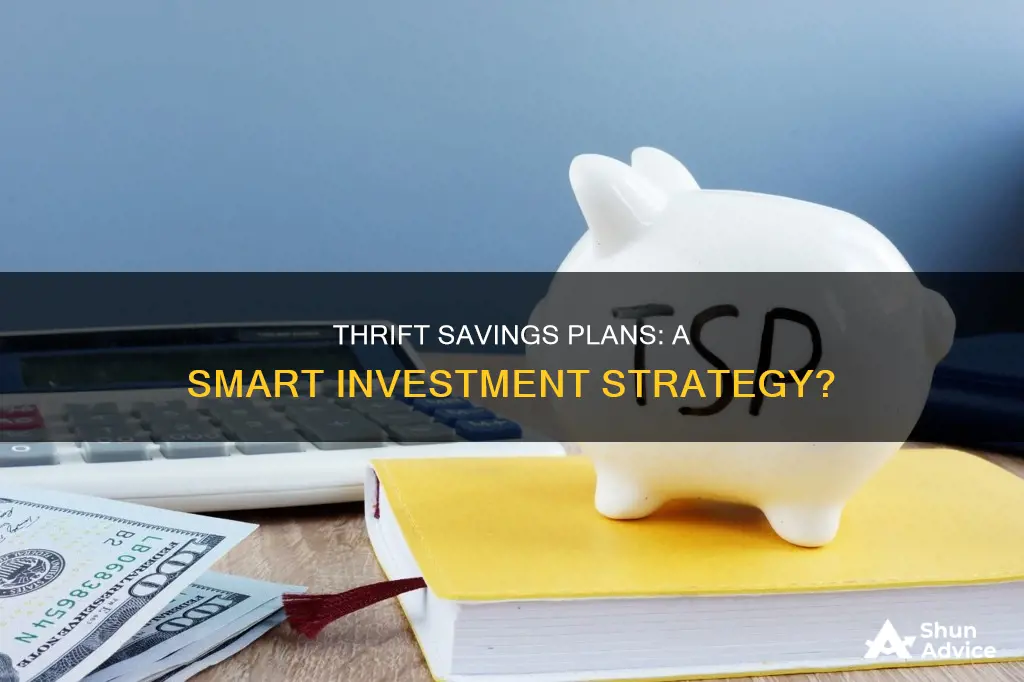
The Thrift Savings Plan (TSP) is a retirement investment program for federal employees and uniformed service members. It is a defined-contribution plan, similar to a 401(k) plan offered by private employers, and provides tax advantages for savers. TSP participants can choose from a variety of investment funds, including government securities, bonds, and stock market index funds. As such, TSPs can be considered an investment option for those eligible.
What You'll Learn

Thrift Savings Plan (TSP) vs. 401(k)
The Thrift Savings Plan (TSP) and 401(k) are both retirement investment plans that offer tax advantages. However, there are some key differences between the two.
Availability
A TSP is only available to uniformed and civilian employees of the federal government, whereas a 401(k) is offered by private employers.
Investment Choices
A TSP offers fewer fund options than a 401(k). A TSP participant can choose from several target-date funds, known as "lifecycle funds", and five to six individual index funds. In contrast, a 401(k) typically offers a dozen or more investment choices, including mutual funds, stable-value funds, and target-date funds. Some 401(k) plans may also allow access to brokerage services, greatly increasing the number of available funds.
Fees
The TSP has much lower fees than a typical 401(k). The total expense ratio for a TSP is 0.066%, or 0.05% according to another source, while the average plan cost for a 401(k) participant was 0.58% in 2017. Private-sector 401(k) plans also charge administrative fees on top of mutual fund fees, which can be as high as 1.5%.
Vesting
With a TSP, employer matches are vested immediately, and automatic employer contributions are vested in two to three years. In contrast, some private-sector 401(k) plans vest employees with 100% ownership of employer contributions immediately, while others may take up to six years. Employees' contributions are vested immediately with both types of plans.
Automatic Enrollment
Federal employees are automatically enrolled in the TSP, with their employer contributing an amount equal to 1% of their pay even if they don't choose to contribute themselves. In contrast, 401(k) plans do not typically feature automatic enrollment, and there is no automatic employer contribution.
Matching Contributions
The federal government matches employee contributions to a TSP up to 5% of their salary. In comparison, private-sector 401(k) plans often match a lower percentage of employee contributions, and some do not match contributions at all.
Understanding the Basics: A Guide to Buying Shares in Investment Trusts
You may want to see also

TSP investment options
The Thrift Savings Plan (TSP) offers a variety of investment options to help participants meet their retirement goals. TSP participants can choose from three main approaches to investing their savings: Lifecycle Funds (L Funds), Individual TSP Funds, and the Mutual Fund Window.
Lifecycle Funds (L Funds)
L Funds are a set of eleven diversified funds, each consisting of a mix of the five individual TSP funds (G, F, C, S, and I Funds). These funds are professionally designed to provide the best expected return for the appropriate level of risk, depending on when the investor plans to withdraw their money. L Funds automatically adjust their asset allocation mix as the participant gets closer to retirement, making them a more hands-off option.
Individual TSP Funds
Participants can also choose their own mix of investments from the five individual TSP funds:
- G Fund (Government Securities Investment Fund): This fund invests in short-term U.S. Treasury securities, aiming to offer a higher return than inflation while maintaining low risk.
- F Fund (Fixed Income Index Investment Fund): This fund mimics the performance of the Bloomberg Barclays U.S. Aggregate Bond Index, investing in U.S. government and corporate bonds, as well as mortgage-backed securities. It offers moderate risks and the potential for higher returns than the G Fund.
- C Fund (Common Stock Index Investment Fund): The C Fund tracks the performance of the S&P 500 Index, investing in stocks of large and medium-sized U.S. companies. It is designed for investors seeking growth through stock investments.
- S Fund (Small Cap Stock Index Investment Fund): The S Fund follows the Dow Jones U.S. Completion Total Stock Market Index, investing in small to mid-sized U.S. companies not included in the S&P 500. This fund offers potentially high growth but with higher volatility.
- I Fund (International Stock Index Investment Fund): This fund invests in a broad index of non-U.S. equity markets, offering growth potential and diversification outside the U.S., but with higher risk.
Mutual Fund Window
The Mutual Fund Window allows participants to invest a portion of their TSP savings in their choice of available mutual funds. However, certain eligibility requirements must be met, and participants must pay the necessary fees to access this option.
TSP participants can choose one or a combination of these investment approaches to build a portfolio that aligns with their financial goals and risk tolerance.
Cattle: A Smart Investment
You may want to see also

TSP contribution limits
The Internal Revenue Service (IRS) has announced the contribution limits for the 2024 Thrift Savings Plan (TSP). The elective deferral limit for 2024 is $23,000, an increase of $500 from 2023. This applies to traditional (tax-deferred) and Roth contributions made by an employee during the calendar year. The combined total of traditional and Roth contributions cannot exceed this limit. It is important to note that this elective deferral limit does not apply to Agency/Service Automatic (1%) Contributions, Agency/Service Matching Contributions, catch-up contributions, traditional contributions made from tax-exempt pay, or amounts rolled over into the TSP.
The TSP will reject employee contributions that exceed the elective deferral limit. Once an employee reaches this limit, their contributions will be stopped for the rest of the year. Federal Employees Retirement System (FERS) and Blended Retirement System (BRS) participants who reach the limit before the final pay date of the year will miss out on matching contributions for the remainder of the year.
For those aged 50 or above in 2024, or turning 50 during the calendar year, additional catch-up contributions of up to $7,500 are allowed. This is in addition to the regular TSP limit, bringing the total contribution limit to $30,500 for the year.
To maximise the 2024 contribution of $23,000 with 26 pay periods, employees should contribute $884.61 per pay period. If maximising the total contribution limit of $30,500, employees would need to contribute $1,173.07 per pay period.
Retirement Plans: Navigating the Investment Danger Zone
You may want to see also

TSP eligibility
Eligibility for the Thrift Savings Plan (TSP) is limited to federal employees and uniformed service members, including the Ready Reserve. This includes most employees of the United States government, who are eligible to participate in the TSP if they are:
- A FERS employee (generally if hired on or after January 1, 1984)
- A CSRS employee (generally if hired before January 1, 1984, and did not convert to FERS)
- A member of the uniformed services (active duty or Ready Reserve)
- A civilian in certain other categories of government service
In addition, eligible employees must be actively employed by the federal government as a civilian employee or as a member of the uniformed services, in a pay status, and working full- or part-time.
For those who are eligible, the TSP offers a defined-contribution (DC) plan that provides many of the same benefits available to workers in the private sector. The TSP closely resembles a 401(k) plan offered by private employers and includes the same tax benefits.
Black Investment: Why So Little?
You may want to see also

TSP investment funds
The Thrift Savings Plan (TSP) is a defined contribution retirement savings and investment plan for federal employees and military personnel. It offers similar tax benefits to those of a 401(k) plan, and many agencies offer matching contributions.
The TSP offers a choice of six funds and a mutual fund option:
The Government Securities Investment (G) Fund
The G Fund is a short-term, risk-free investment that invests in very low-risk, low-yield government bonds. It is the only fund in the TSP that guarantees the return of the investor's principal. This fund is intended for conservative investors and has historically provided the lowest rate of return.
The Fixed-Income Index Investment (F) Fund
The F Fund is a bond index fund that tracks the Lehman Brothers US. Aggregate (LBA) bond index. It represents the next step up in risk and potential reward compared to the G Fund. This fund pays monthly interest, typically higher than that of the G Fund, but does not guarantee the return of the investor's principal.
The Common-Stock Index Investment (C) Fund
The C Fund is the most conservative of the three stock funds available in the TSP. It invests in the 500 large and mid-cap companies that comprise the Standard and Poor's 500 Index. This fund has experienced greater volatility than the G or F Funds but has delivered higher returns over time.
The Small-Capitalization Stock Index Investment (S) Fund
The S Fund holds the same securities as the Dow Jones U.S. Completion Total Stock Market Index, which includes over 4,000 companies. These companies are smaller and less established than those in the C Fund, offering higher risk and higher potential returns. The S Fund has outperformed the C Fund with greater volatility over time.
The International-Stock Index Investment (I) Fund
The I Fund is the only TSP fund that invests in companies outside the US. It invests in securities mirroring the Morgan Stanley Capital International EAFE (Europe, Australasia, Far East) Index, which covers 21 developed countries. This fund is considered high-risk and has historically posted higher average annual returns than the C Fund.
Lifecycle (L) Funds
Lifecycle funds are composite funds that invest in a combination of the five core funds. They act as "automatic pilot" funds for participants who don't wish to make their own asset allocations. L Funds are designed to provide income for those who will begin taking distributions within five years of the maturity date.
Mutual Fund Option
The TSP also offers a mutual fund window for participants who want more flexibility in their retirement investments. This option allows participants to invest a portion of their TSP savings in available mutual funds of their choice. However, there are certain requirements, such as having a minimum balance of $40,000 in the TSP account and not investing more than 25% of the account balance in mutual funds.
Life Insurance Investments: Friend or Foe?
You may want to see also
Frequently asked questions
A Thrift Savings Plan (TSP) is a retirement investment program open only to federal employees and uniformed service members. It is a defined-contribution (DC) plan that offers federal employees many of the same benefits that are available to workers in the private sector.
A TSP closely resembles a 401(k) plan offered by private employers. Participants in a TSP can get an immediate tax break for their savings and choose to invest in a Roth for freedom from taxes after retirement. There are several ways to invest in a TSP, including automatic payroll contributions, agency matching contributions, tax-deferred contributions, and after-tax investments.
The contribution limit for a TSP is $22,500 for 2023 and $23,000 for 2024. Employees aged 50 and over can also make catch-up contributions of $7,500 in either year.
There are two main types of TSPs: traditional TSPs and Roth TSPs. With a traditional TSP, contributions are made with pre-tax dollars, and taxes are paid upon withdrawal. With a Roth TSP, taxes are paid on contributions upfront, and withdrawals are tax-free.
If you quit your job, your TSP will remain active and continue earning if the balance is $200 or more. You can control the account and adjust your investments, but you cannot make any new contributions.







